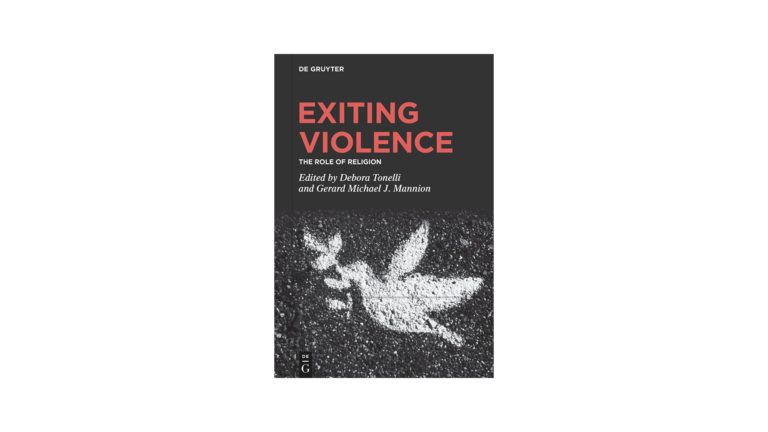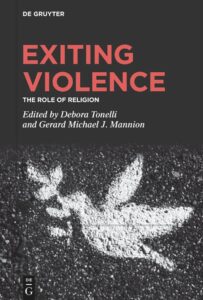
Scholar Q&A: Debora Tonelli
IACS Affiliated Scholar Debora Tonelli is Georgetown’s representative in Rome and a research fellow at the university’s Berkley Center for Religion, Peace and World Affairs. She is also a permanent researcher at FBK-ISR and an invited lecturer in Political Philosophy and Politics and Religion at the Pontifical Athenaeum of Saint Anselm, and in Religion, Violence and Religious Freedom at Gregoriana University. Her background is in political philosophy and Theology. Her current research and teaching activities are focused on the interaction between those two main fields, specifically inside the wider context of interreligious dialogue, with a key focus on the relationship between violence and biblical religions, and the influence of literary images in the construction process of “religious imagery” supporting a violent conception of divinity and justifying violence in the name of God. Her publications include: “Exiting Violence: The Role of Religion” (De Gruyter 2024) (co-edited with Gerard Mannion), a collection of essays resulting from a larger research project.
Tell us about the Exiting Violence project and how it came about?
The project started from afar. First, it arose from the combination of two important elements of my academic background. The first is my studies in political philosophy and First Testament exegesis from a Christian perspective, in which I had addressed political issues by analyzing biblical texts. Here the goal was to rediscover the biblical roots of modern Western political thought, moving beyond questions of membership and/or adherence to a religious tradition and focusing on resources that can help us better understand the current context. In my doctorate in First Testament Exegesis, in particular, I had dealt with images of divine violence, analyzing Ex 15, Judges 5 and Habakkuk 3. I did not want to be an apologist for divine violence, but neither did I want to deny it. Rather, I placed those texts in their cultural-historical context, analyzed their vocabulary and references to other earlier texts and traditions. That analysis showed how literary images of divinity help construct the mental imaginaries¹ of the believers who hear and/or read those texts. Obviously, these imaginaries are enriched by the categories and meanings of the reader who, in some cases, can deform or otherwise transform them. We will never be able to reread and understand those texts in the way that their original readers did, and yet those texts still interpelate us. Above all, we are challenged by the fact that they often speak of a deity very different from the one outlined by pastoral care and Christian catechisms or preaching today. The formative intent of those texts meets the interpretive freedom of the reader.
Gradually my research question changed from “why is God violent?” to “why did the authors of those texts believe they encountered God even in violence?” The question was not to “deny” Revelation, but to admit that the testimony of believers is rooted in experience. Discerning what does and does not come from God is not easy. Faith must feed on doubt, and the scholar cannot indulge in evidence that is not adequately substantiated.
Hence, my thinking came naturally to dissociate divine violence from violence perpetrated by human beings in the name of God, to dissociate images from imaginaries and Revelation from instrumentalization. Thanks to the Bruno Kessler Foundation, I was able to organize a series of closed-door seminars in which, with a small group of scholars, we discussed different aspects of divine violence and its political implications. The first, held by Prof. Martin Morales, S. J., was on the Inquisition. Together with Massimo Rosati first and Gerard Mannion later, I discussed the topic at length, particularly in its social, political, and ecclesial implications. Gerard and I tried to understand the practical consequences of a certain view of God and divine violence and whether it could somehow legitimize violence among human beings “in the name of God.”

Gerard Mannion invited me to spend a study period at the Berkley Center for Religion, Peace and World Affairs at Georgetown University. That stay at Georgetown was decisive in seeing the complexity of the issues at stake, the dynamics between religion and violence, the layers of conflict. I had the opportunity to engage with scholars who had experience in the field, such as Katherine Marshall. There I also met Leo Lefebure, Jocelyne Cesari, José Casanova and many others. That was how the project “Religion and Violence” was born. Reset Dialogues, with whom I had already collaborated, supported the project from the beginning. The Kessler Foundation, Reset Dialogues and the Berkley Center gave Gerard and me the opportunity to organize two international conferences (Trent, 2017; Washington, D. C., 2018) gathering scholars from all over the world from different disciplinary fields and knowledgeable about different religious traditions.
It was extraordinary to see the combination of so many different perspectives and methodologies. More than finding solutions, we shared perspectives and narratives and we came to see that how conflicts are described is critical to their resolution. Gerard and I then collected a selection of articles from those conferences to create a book that would reflect on how religion can be a tool to get out of violence—that book is Exiting Violence. The unspoken assumption is that violence is not a destiny; rather, we can choose other paths.
We therefore had to clarify concepts such as “theology,” “religion,” and “spirituality” and understand which of these come into play in the dynamics of conflict. The role of textual hermeneutics, then, is not secondary: the interpretation of sacred texts often says more about the interpreter than about the text being interpreted. In the course of the work, a variety of possible conflicts attributable to religious traditions emerged. More generally, every conflict is composed of several levels, and the one related to economic and political motivations is fundamental. Theological/ideological issues typically constitute the narrative that serves to drive people toward conflict—but the fundamental motivations are typically economic and political. This is one reason why knowledge of religious traditions and interfaith dialogue are powerful weapons: they unhinge attempts to instrumentalize religions. No God wants the destruction of humanity.
Religion has often been perceived as a big part of the problem of violence and war. The book acknowledges that, but argues that religions can either sacralize violence (that is, can sanction violence from within their worldview) or can work against violence. Would you give an example of each from the book?
When we talk about “religion,” we are talking about customs, customs, and belief systems that express adherence to a certain view of divinity and/or the meaning of existence in relation to a cosmic order. We expect that, somehow, such customs and belief systems will make order, that is, maintain harmony among human beings. When this does not happen or even causes conflict, we are outraged because it contradicts the very reason why a human being decides to embrace a certain belief system. This happens when we meet people of different faiths or who express the same faith in different ways. However, each person should recognize that “believing” does not mean imposing. If the purpose of faith is to experience God’s love, any form of imposition is contradictory to this purpose.
If the purpose of faith is to experience God’s love, any form of imposition is contradictory to this purpose.
The Second Vatican Council profoundly changed the way the Catholic Church relates to other religions and cultures. Thus the book reports several examples where religion becomes a vehicle for peaceful coexistence among people who embrace different forms of beliefs. For example, Wolfgang Palaver analyzes the Focolare movement and its commitment to interreligious dialogue, consistent with the nonviolent tradition of Jesus. Vincent Sekhar discusses contextual theology in India, a vast reality rich in millennia-old traditions in which the Christian message must continually confront very different realities. In his contribution, Sekhar reflects on the role of God in history, that is, the relationship between theology and cultural context.
From this perspective, India offers many opportunities for reflection and practice. Maryann Cusimano Love instead focuses her attention on the role of women of faith in the social and legal spheres to build peace. The network of women believers in Iraq is a concrete example of this possibility, and there are many societies where inclusive practices could support the peacebuilding process.
More generally, as José Casanova points out in the Preface, every religious tradition possesses a collective memory, hermeneutical resources, and practical moral resources useful not only for exiting violence but also for offering a prophetic voice capable of being critical of modern secular ideologies that tend to sacralize both the state of violence and the structures of unjust domination.

This is because the Sacred Texts have a formative and not an “informational” intent: they are not manuals of “good behavior,” but uncomfortable interlocutors before whom it is necessary to reflect and take a stand. I think that when faced with the immutability of the text, the reader cannot entrench himself behind a literal interpretation. The book strives to show that there are many ways to interpret the sacred text, but some are better than others because they are part of a path of inner discernment.
Over the course of the project, what surprised you most about the intersection of religion, politics and the prevalence of violence?
What most struck me was the difficulty with which people approach sacred texts. Most people formulate their reflections from what they heard from educators when they were growing up. If the experience was positive, there is a chance that he will continue to read those texts when he grows up, regardless of whether he adheres to that faith. If the experience was negative, he probably won’t. Noone would dream of doing the same with math: whether you had a good math teacher or not, you know that knowing how to count and do math will make your life better.
Religious traditions, on the other hand, are “intangible” to the point where you think you can do without it. Nor is it necessary to adhere to a religious tradition in order to know something about it. Each tradition carries some of humanity’s heritage of wisdom: it makes no sense to throw any one of them away just because one does not adhere to that belief system, because their questions are still valid today. Perhaps the real issue is not so much their content, but feeling betrayed by bad teachers. No one will say that math is “illogical” just because they had a bad teacher, while they will almost certainly say that religion is hypocritical if their catechist created scandal.
All this is self-defeating, however, because in the face of an increasingly secularized West, in other parts of the world the number of believers continues to grow: if we want to be in relationship with others, we must learn to know the places where they seek their own answers. This, as Jocelyne Cesari explains well, does not necessarily mean adhering to that religious tradition.
Who would you most like to read the book?
The book is aimed at scholars and students, those interested in exploring the dynamics between religion and violence from an interdisciplinary and multi-religious perspective. Rather than answers, the volume offers tools for repositioning questions, for understanding how we associate our idea of religion and violence with reality and how different experiences alter the meaning of these concepts.
¹ Editor’s note: “mental imaginaries” are the mental images through which people interpret their experience, i.e. the way the imagine the world in which they live and how it functions.